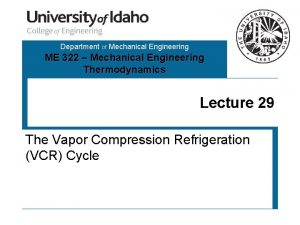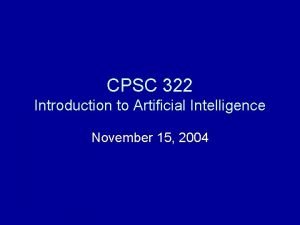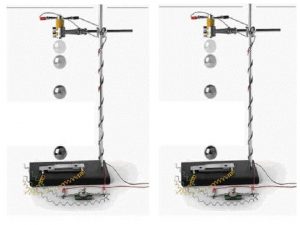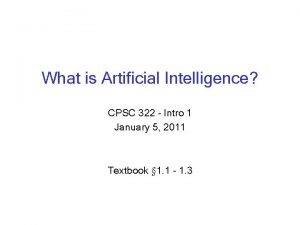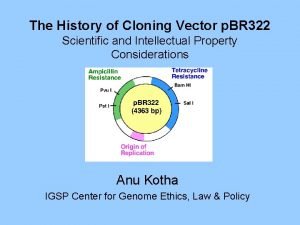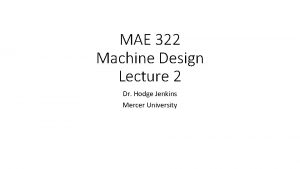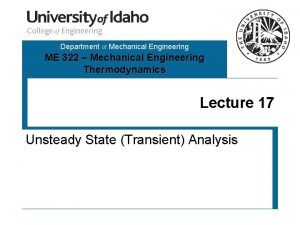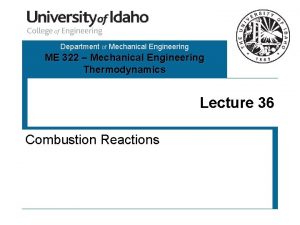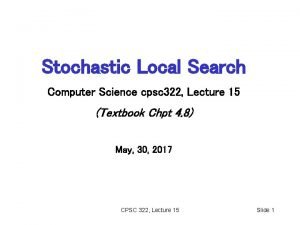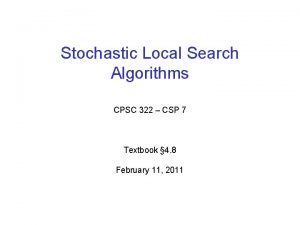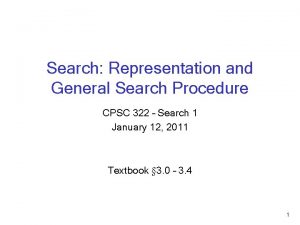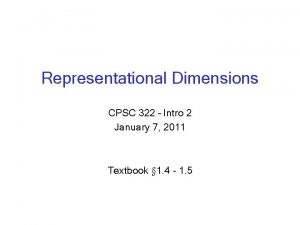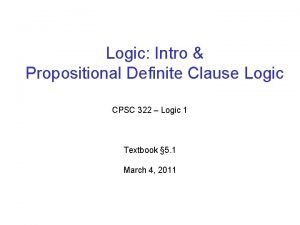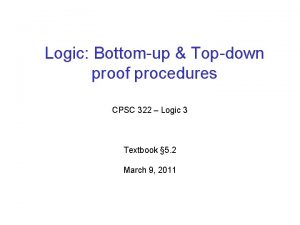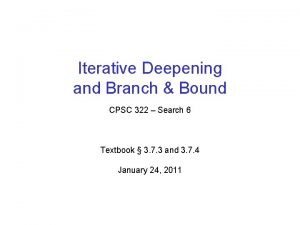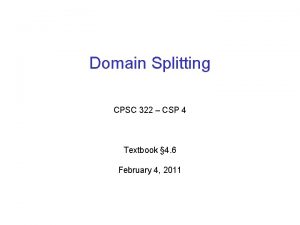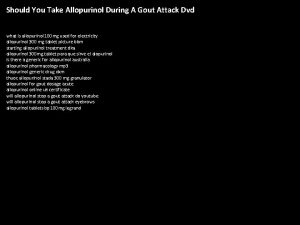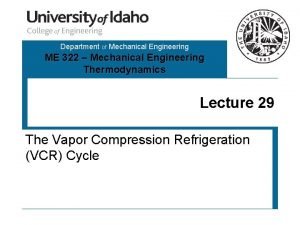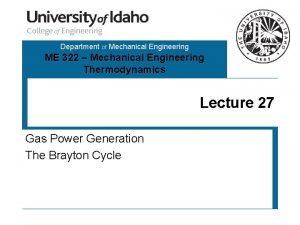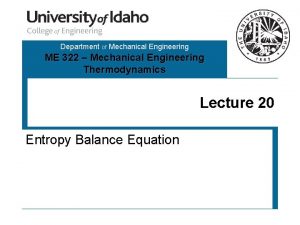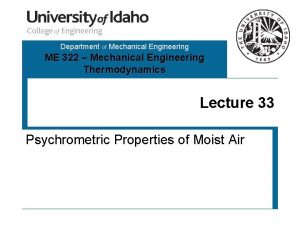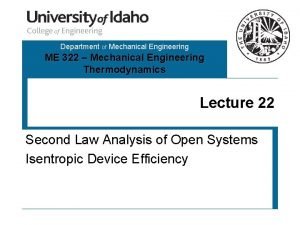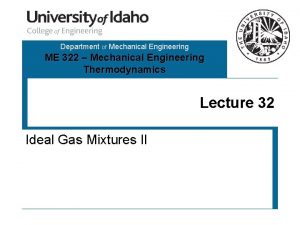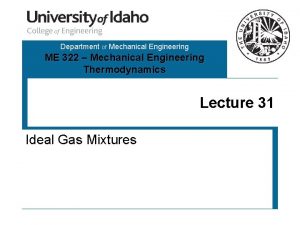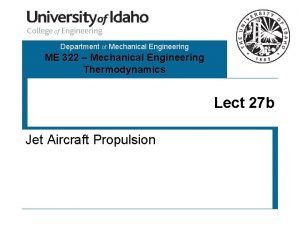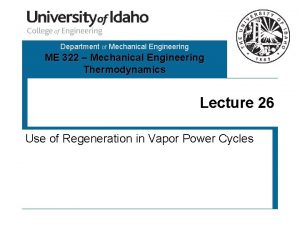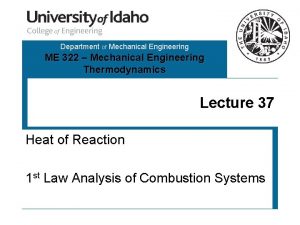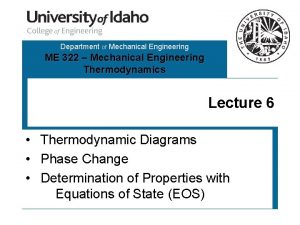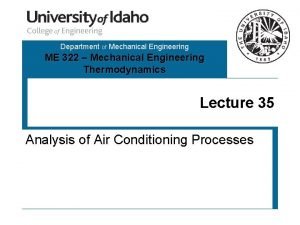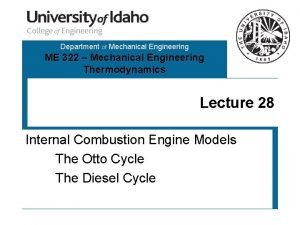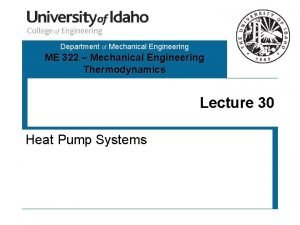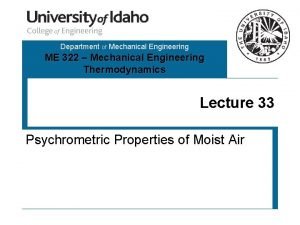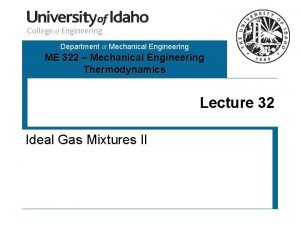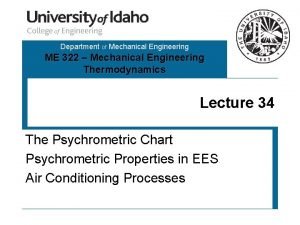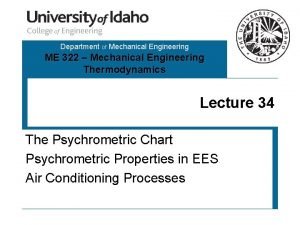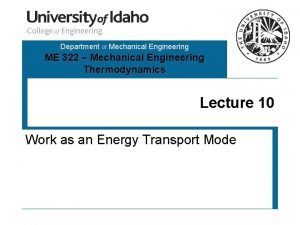Department of Mechanical Engineering ME 322 Mechanical Engineering


























- Slides: 26

Department of Mechanical Engineering ME 322 – Mechanical Engineering Thermodynamics Lecture 37 Heat of Reaction 1 st Law Analysis of Combustion Systems

Combustion System Analysis Consider the complete combustion of octane in 150% theoretical air, C 8 H 18 PTA = 150% Combustion Chamber Products (p) In the previous lecture, we found the balanced reaction, The First Law applied to the system identified above is, 2

Combustion System Analysis C 8 H 18 PTA = 150% Combustion Chamber Products (p) reactants combustion (air and fuel) products Potential issue: There are no Dh values (except for O 2 and N 2). This has the potential to cause a datum state problem. 3

Resolving the Datum State Problem In combustion calculations, the enthalpy of all stable* elements is defined as zero at the standard reference state (SRS), *‘Stable’ means chemically stable at the SRS. For example, diatomic oxygen (O 2) is stable at the SRS. Monatomic oxygen (O) is not stable at the SRS. 4

Enthalpy of Formation The enthalpy of a compound at the standard reference state Heat released in an exothermic reaction (or absorbed in an endothermic reaction) when a compound is formed from its elements. (Elements and compound at the SRS) Example – Methane 25°C 1 atm C 2 H 2 5 CH 4 25°C 1 atm


Enthalpy of Formation Values Using EES* … *Unit setting = molar 7

Enthalpy of Formation Values Results. . . Conclusion: EES uses the SRS as the datum state for enthalpy for the ideal gases! Therefore, enthalpy of formation values can be calculated from EES using the ideal gas substances (except AIR) 8

Enthalpy Values in Combustion What do we know so far? 1. The enthalpy of a stable element at the SRS is 0 2. The SRS is 25°C, 0. 1 MPa 3. The enthalpy of a compound at the SRS is the enthalpy of formation (Table 15. 1 or from EES) 9

Enthalpy Values at Other States The enthalpy of a component at any temperature in a combustion process can be evaluated by, Accounts for the enthalpy difference relative to the SRS How is the enthalpy difference in brackets determined? ? 10

Enthalpy Values at Other States Three possibilities. . . 1. If the heat capacity of the component can be assumed constant, 2. If the constant heat capacity assumption is not accurate enough, then use the ideal gas tables (Table C. 16 c). In this case the datum state for the table does not have to match the enthalpy of formation. 3. Use a set of property tables for all components that has all enthalpy values referenced to the SRS. Does such a thing exist? 11

Enthalpy Values at Other States Exploring Option 3 from the previous slide. . . If a thermodynamically consistent set of tables exists, then Therefore the enthalpy of the component could simply be looked up in a table at the given temperature, If something like this were available. . . combustion calculations would be EESy! 12

Enthalpy Values at Other States ALL of the ideal gas enthalpy reference states (except for the ideal gas ‘AIR’) in EES are referenced to the SRS! This is from the EES Help Menu for the ideal gas CO 2. . . All other ideal gases in EES (except AIR) say the same thing! Significance: Combustion calculations just became EESy! 13

Heat of Reaction Consider an aergonic combustion process as shown below Fuel Reactants (R) Air Combustion Chamber Products (P) The First Law applied to this system results in, Dividing by the molar flow rate of the fuel, 14

Heat of Reaction The molar flow rate ratios are the molar coefficients from the balanced combustion reaction! Therefore, This is known as the molar heat of reaction. 15

Heating Values of Fuels Given: Gaseous octane (C 8 H 18) is burned completely in 100% theoretical air. The reactants and the products are at the SRS. Find: The heat released during this combustion process per mole of fuel for the following cases, (a) the water in the products is all vapor (b) the water in the products is all liquid 16

Heating Values The system boundary is drawn around the combustion chamber. Applying the First Law results in, Dividing both sides of this equation by the molar flow rate of the fuel, Number of moles of reactant per mole of fuel Number of moles of product species per mole of fuel How are these found? 17

Heating Values The molar flow rate ratios on the previous slide are the molar coefficients from the balanced combustion reaction (for one mole of fuel)! Therefore, Observations. . . Notice: PTA = 100% means stoichiometric combustion 1. The importance of being able to balance the combustion reaction is evident! 2. As long as the combustion process is aergonic, the First Law will be as written above, independent of the conditions in and out of the combustion chamber! 18

Heating Values For the complete combustion of normal octane in 100% theoretical air, we previously found, Applying the First Law to the system, 19

Heating Values Now we have an interesting problem. Is the water liquid or gas (or both)? 20

Heating Values Let’s consider both extremes (1) the H 2 O is all vapor and (2) the H 2 O is all liquid. All vapor water. . . All liquid water. . . 21

Heating Values All vapor water. . . Lower Heating Value (LHV) All liquid water. . . Higher Heating Value (HHV) Observations. . . 1. The reactants and products are at the SRS 2. The reaction occurs with PTA = 100% (xi = ni ) 3. The difference between the HHV and the LHV is the enthalpy of vaporization of water! 22

Heating Values 1 mol fuel TSRS, PSRS TSRS Products (vapor H 2 O) Stoichiometric air Products (liquid H 2 O) 23

Heating Values The heating values represent the maximum possible heat transfer that can occur per mole of fuel. • The reactants and products are at the SRS • The HHV represents fully condensed water vapor • The LHV represents all water vapor These values provide a basis for the combustion efficiency, 24

Example Back to our problem. . . Is there liquid water in the products at the SRS? If so, how much? Will water condense? Since TSRS < Tdp, water will condense 25

Example How much water will condense? At TSRS = 25°C, the mole fraction of water vapor in the products is, The mole fraction of the water vapor at 25°C can be found, 26
 Ankara university
Ankara university Me 322
Me 322 Ssis-322
Ssis-322 Mycin
Mycin Nació en macedonia en el 384 a. c.
Nació en macedonia en el 384 a. c. Que es decreto 3222 de 2002
Que es decreto 3222 de 2002 Fe 322
Fe 322 Aristote 384-322
Aristote 384-322 Cpsc 322: introduction to artificial intelligence
Cpsc 322: introduction to artificial intelligence Br 322
Br 322 Distortion energy theory formula
Distortion energy theory formula Cpsc 322: introduction to artificial intelligence
Cpsc 322: introduction to artificial intelligence Me 322
Me 322 Me 322
Me 322 Combustion example
Combustion example Ubc cpsc 322
Ubc cpsc 322 Cpsc 322
Cpsc 322 Cpsc 322
Cpsc 322 Cpsc 322
Cpsc 322 Cpsc 322
Cpsc 322 Rrs research
Rrs research Cpsc 322
Cpsc 322 Iterative deepening search example
Iterative deepening search example Cpsc 322
Cpsc 322 Allopurinol gador 300 mg
Allopurinol gador 300 mg Neolithic rap
Neolithic rap Me 322
Me 322

